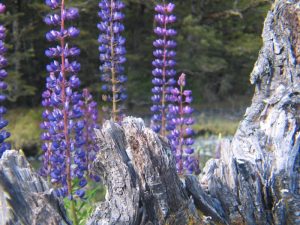 Bumbling into a Big Bird better than Popeye’s in a primary rainforest on a remote New Zealand isle, John M. Edwards raves, “Don’t mess with dinner!”
Bumbling into a Big Bird better than Popeye’s in a primary rainforest on a remote New Zealand isle, John M. Edwards raves, “Don’t mess with dinner!”
Part I
In Auckland, New Zealand, I was roosting in the common room of this crap budget flophouse, perusing my guidebook and gearing up to fly to Fiji soon despite a recent military coup, when the heated roundtable discussion of the relative cleanliness and cheapness of Kiwi backpacker hostels was interrupted by a scruffy young dolebludger:
“Hey, did you hear about the Yank who got stuck out in the bush on Stewart Island and had to be rescued?”
My eyes fluttered off the South Pacific map and up, up.
What what?
He wasn’t talking to me, nor did he know he was talking about me!
New Zealand is a small world. In the “other downunder,” word travels quickly and it doesn’t take much at all to get famous. Still, it was somewhat disconcerting to be discussed so recklessly in the third person. Like a funereal fly on the wall, I eavesdropped, feeling an odd admixture of pride and paranoia as the mercurial messenger embellished on the tale of my bad trip of two months ago, even venturing an apocryphal comparison of yours truly with the Wild Boy of Aveyron. For my part, I led him on incognito with the occasional smartass question.
In so-called Abel Tasman’s Land, I experienced the premature letdown of my fifteen minutes of fame.
I flew to the Antipodes where the stars are different and water circles counterclockwise down the drain, then went off in search of a fabulous lost bird.
Like the ancient Maoris before me, who circa 1000 A.D. paddled ashore in their ornately carved canoes, donned their mystical jade talismans, tattooed their faces, brandished their sharp spears and akeake clubs, and barbecued this largest species of land bird to ever walk the earth, I had arrived in The Land of the Long White Cloud to hunt down the Moa.
While no Sinbad’s Roc, Dinornus maximus (the Moa), a flightless native New Zealander resembling the ostrich and distantly related to the kiwi, was still the very stuff of nightmare Thanksgivings. British colonial sketches pictured a kind of benevolent-looking creature like Big Bird from Sesame Street, but without the goofy expression and cheery yellow feathers. In Following the Equator, Mark Twain claimed that the “Moa stood thirteen feet tall, and could step over an ordinary man’s head or kick his hat off; and his head, too, for that matter.” On average, though, this terra-firma-bound, weak-winged, furry dark bird — if this monstrorum artifex can fairly be dubbed a “bird” — stood ten feet tall and weighed in at a whopping quarter ton. Unlike most topheavy flying birds, she bore a flattened sternum like the breastplate of a medieval Maltese knight; her terrible swift beak could descend like a plastic cocktail bird toy and crack open a human skull as if it were a farm-fresh egg. An insatiable herbivore, she could hop unimaginable distances in relentless pursuit of grass, leaves, berries, seeds, and her only natural enemy: man.
Any way you sliced it, this bird meant business. Big business. Even Colonel Sanders would have winced with orgiastic delight digging into a bucket of their gamey gargantuan buffalo wings. Still the idea of attempting to purloin an oversize pre-Purdue oven stuffer with a temperamental flock of Food of the Gods chooks hopping behind at 40 m.p.h. quite frankly gave me the heebie jeebies. I’d track down this fearsome poultry giantess, yes, but not with an elephant gun; instead, I’d shoot her with a duty-free autofocus Nikon, zooming in from a great distance away.
The only real problem was that the Moa was now supposedly extinct.
“Won’t find no Moas round here, just a luttle fesh ‘n’ chups and mooshy peas at the pub,” said Gavin, a ginger-haired South Island sheepshearer, squinting up at me with a Winfield cigarette tucked into an impish grin. He wore a fuzzy brown Swandri parka and was doing a fair job of fleecing the golf balls off a bleating cloud of mutton. “You’ll be lucky to spot even a kiwi, mate.”
A silent Maori truckie had just deposited me at a sheep station outside Dunedin (Celtic for “Edinburgh”), a foggy Victorian city whose Cadbury factory makes the whole area stink of chocolate. After seven months of hitchhiking in the Southern Hemisphere (six months in Australia and already a month in New Zealand’s South Island), I couldn’t help thinking that I’d somehow taken a wrong turn, scaled Hadrian’s Wall, and ended up upside-down in the land of the Picts.
“Now, if you’re keen on baggin’ a kiwi instead,” Gavin shouted, razoring away amid the piping castrato pleas of the bah-bah, “go for a lookaround on Stewart Island. Nothing but bloody birds and pomes [“prisoners of Mother England”] huntin’ and trampin’ all over the bloody bush.”
I noticed with alarm that the shivery razor-nicked sheep was sporting a long bushy tail!
Gavin explained that his sheep were bound for Iran and that all sheep do have tails, of course, until they are hacked off to the nub — from the look of it, for sage reasons of hygiene. The Persians, he told me, slaughter their sheep wholesale by slitting their throats facing Mecca, with outlandish ceremonial daggers. There are over seventy million sheep and only three million people in Abel Tasman’s Land. Neither species is native to New Zealand.
Since the last Moa was reportedly offed in the early 19th century, I adjusted my plans accordingly. Now my sights were more modestly set on capturing on Kodak 100-speed film a negative nocturnal kiwi, as absurd a bird as ever winglessly walked the earth. But if mildewy mammoth Moa skeletons were still unearthed throughout New Zealand to decorate museum wildlife displays and dioramas, wasn’t it at least possible that a modern Moa refugee camp lay hidden away somewhere in the barmy bush?
Anything was possible in the world’s strangest topographical dreamscape, where fjordlands (Milford Sound), alps (Mount Cook), and glaciers at sea level (Franz Joseph and Fox glaciers) lay only a couple of hours away from active volcanoes (Tongariro National Park), tropical beaches (Coramandel Peninsula), and primary rainforests (Stewart Island). Way off the beaten track on Stewart Island, a place chockablock with rare endemic species of warmblooded flightless vertebrates, I hoped to find my bird — a bird that like man wasn’t meant to fly, but unlike man still had the clipped remnants of wings.
I bussed it to flat and featureless Invercargill, the gateway to Stewart Island. Invercargill’s only other claim to fame was that its museum held a real live tuatara — the only true reptile to survive the age of the dinosaurs. If this last South Island outpost had managed to trap a prehistoric Mesozoic “lizard,” I reflected during the prop plane flight over the Foveaux Strait toward an uncertain future, what other evolutionary curiosities would I find a little farther south toward Antarctica, in the little lost world of Stewart Island? As the “Tierra del Fuego” of New Zealand, the remote third island was not only an unspoiled “tramper’s paradise” but also the closest you could get to the South Pole and still down a schooner of beer in a pub. Like every traveler who makes it this far, I at least wanted to get a T-shirt from the famous South Sea Hotel.
From above, I fancied the island looking like it was about to hatch.
I had a major score to settle, you see, with our little feathered friends.
Months earlier, I was riding a bike in the lush green countryside of New South Wales, Australia, when the magpie attacked.
It came swiftly and hit like a premonition.
A savage Woody Woodpecker beak repeatedly rogered holes into the back of my head until I squeezed the brakes, flew headfirst over the handlebars, and landed in a nest of tall grasses. With prehistoric shrieks of bird and blood beating in my ears like the thrumming pulse of pterodactyl wings, I prepared to rip the magpie apart with my bare hands. An animal moment. But the avaricious avian assassin just fluttered off into the wild blue yonder, shrilling Hitchcockian curses: Tippi Hedren! Tippi Hedren!
The pain had been quite unlike anything I’d ever experienced.
“Ya can’t get too close to their nests!” said the scarecrowy farmer later, stinging the warm sticky back of my head with a whiskey-soaked rag. In the fierce sunlight, firefly phantoms buzzed; I felt dizzy, like crying. “They’re just protecting their young? Same thing happened to a sepo [Septic Tank Yank = American] just last week? Luckily around here magpies go for the back of the head? Another breed goes straight for the eyes? Get that, mate? Straight for the eyes! People wear caps with buttons sewn on back to fool ‘em?” The farmer’s gawky pet Emu pecked awkwardly outside the barn, orbiting within the limits of her chain.
“Are ya a Yank? No wuckin’ furries, mate! I thought you were maybe Canadian? Where ya from? How long ya been in Oz?”
I was from New York and beginning to feel the gravitational pull of homesickness. Until that moment I knew almost nothing about birds, except that I had just nearly been killed by one.
In the Southern Hemisphere, the natural world was a frightening and bewildering place. Those How and Why Wonder Books I read as a juvenile could not have prepared me for any of this. In Australia, there was a plant called a “stinging tree” that secreted a poison so powerful that one simply died from the pain: I’d heard plenty of rumors of what happened to campers squatting in Queensland rainforests and grabbing the nearest leaves. There was also that newspaper item about a man taken by a saltwater crocodile right out of his tent near Darwin in Kakadu National Park, matter-of-factly drowned in a “death roll,” and stuck under a riverbank to decompose. The only problem being that the half-chewed man woke up in medias res, muttering, “How in earth did I get here?!”
What was I doing here? So far, I’d swum in a lake full of floating logs that turned out to be freshwater crocodiles, which supposedly don’t attack humans (Catherine Gorge), I’d nearly sat down on an outhouse seat beneath which lived a poisonous redback spider (Coober Pedy); I’d inadvertently allowed a poisonous taipan to slither menacingly across my toes (Magnetic Island); I’d been pestered by lepers in a pub, even though dry leprosy, they say, isn’t contagious (Broome); I’d met folk who knew surfies who’d lost their legs to Great White sharks, and I gave windsurfing a go anyway (Perth); and I’d entered a remote mining town straight out of Wes Craven’s “The Hills Have Eyes,” and quite promptly fled (Tasmania). I couldn’t wait to leave this puzzling jigsaw piece of the former supercontinent of Gondwanaland. My Australian visa was almost up; I’d soon be forced onward to New Zealand anyway.
Unlike the oldest continent in the world, relatively new New Zealand had no dangerous animals or snakes and only one poisonous spider (the ketipo), but it did have lots and lots of birds. Many of them who couldn’t be bothered flying anymore and preened and strutted about the place as if it were they who lorded it over the earth. In fact, the whole godforsaken antipodal demesne had literally become a retirement home for strange endemic species of uncompetitive birds, who had bred and evolved for over a hundred million years in isolation, unmolested by predatory mammals. This time I’d go prepared.
Who knew what exactly might be hiding out there in the bush?
Part II
As a kid I was fascinated by the names on an old globe from between the wars and surprised to discover that many of the countries no longer existed. When the South Pacific god Maui stuck Aotearoa between the Indian and Pacific tectonic plates, he probably hadn’t a clue either that the Oceanian island group would end up being served up to the world as New Zealand, populated not by a modest tribe of Polynesians eating off palm leaves but by a huge colony of Brits dining off Delftware.
In the beginning, Maui paddled here in a canoe, dropped anchor, and caught a big fish. The fish became the North Island, the canoe the South Island, and the anchor Stewart Island, a.k.a. Rakiura, The Land of the Glowing Skies. In 1642, the Dutchman Abel Janszoon Tasman “discovered” what he called Staten Landt, later renamed Nieuw Zeeland, but remained unaware of little Rakiura. In 1770, Captain Cook, the first pakeha (European) to spot Rakiura, thought it was part of the South Island and misnamed it Cape South. In the 19th century, Captain Chase finally circumnavigated the island on the sealing vessel Pegasus, renamed it after his first officer William Stewart, and bought it from the Maoris not for gaudy trinkets but for six thousand pounds.
How the shrewd Maoris must have laughed! Nobody really owned this island, after all, and who would want to? The Maori Moa hunters had already eaten up, or so they thought, every last one of the godlike birds who once prolifically capered around on this 650-square-mile paradise lost of prehistoric tree ferns, nikau palms, and podocarps. The British were now stuck with a muddy dumpster, teeming with a farrago of piddling aviatrix appetizers, such as parakeets, pigeons, cormorants, oystercatchers, penguins, takartres, keas, and kakas. Also the Kiwi, which New Zealanders rely upon today as slang not only for the fruity Chinese gooseberry but also for themselves (“Kiwi” is slightly less awkward than, say, “New Zealandian”). Today, Stewart Islandian kiwis were the only ones to escape the endangered hit list, maybe because many critters on this largely unexplored enigma had never beheld human footprints.
On Stewart Island, all roads, including the crude airport landing strip, end abruptly in the bush. After a rainy night in Oban (pop: 500), a former 19th-century whaling station and now the only inhabited settlement, I left this sleepy fishing village on Halfmoon Bay snoring away with diesel generators, then followed the “metal road” (gravel path) to the Jurassic park of muddy trails and trampers huts. On the map, it looked as if I could just connect the dots hut to hut and make the short northern circuit in a week flat: Oban-Port William-Big Bungaree-Christmas Village-Long Harry-Benson Peak-Freshwater-Oban. No problem. I planned to take my time, stop in rocky bays and inlets for cold invigorating swims au naturel, perhaps do a detour and climb Mount Anglen (1060 meters) for bird’s-eye views, and definitely forage around off the path for rare flightless birds: rails, kakapos, wekas, kiwis. . . .
Feeling like a dapper explorer in my Levi’s, brand-new South Sea Hotel T-shirt, and rented pair of Wellingtons, I double-checked my swag: a compact Fairy Down sleeping bag, a mini Mag Lite, a Swiss Army Knife, a fifth of Glenfiddich, my journal, a couple spare pairs of undies and socks, and as much food, cigarettes, candles, lighters, and toilet paper as I could hastily stuff in my Caribou day pack. More important was the copy of Samuel Butler’s Erewhon that I’d nicked from some hostel. It was wise to travel light. Aside from hiking trips when I was a kid at camp in Maine, I’d never been on a long walkabout in the wilderness.
By a trick of Mercator’s projection, a few hours betwixt huts marked on the atlas translated into double time and despair in the real physical world. The spirit of Oban’s South Sea Hotel hamburger — served in the “downunder” style (that is, topped by a fried egg and thick slab of sickly sweet beetroot) — had returned to haunt me repeatedly like the steamy aftermath of a broken Polynesian tapu (taboo). Hell, it did rain every day in the “rainforest”: heaps! The first day was rough, the second torture, the third impossible. And there I was trudging along hangdog, soaking wet and up to my knees in carnivorous prelapsarian muck and cosmic drool.
“Should’ve called this swampy hellhole Bog Island!” I screeched in rage. Beneath the riotous canopy, sinister invisible birds whooped it up behind the twisty trees and ferny brambles, shrilling, booming, trilling. It was louder than a city in here, yet I could see nothing beyond the primitive thatched roof overhead. Bewildered, bruised, I was oh-so careful not to step even a foot off the so-called track, as I bum-slid down muddy mountain and forded flash streams up to my waist. All this for the rare privilege of slogging toward the third hut with the vaguely promising name of “Christmas Village.”
I was already running out of food and had left without my mackintosh. Worse, nobody knew I was out here.
At last! Christmas Village. On a rocky beach beneath a real patch of cerulean sky, this wooden hut featured bunk berths, a wood-burning stove, a full water tank, even an outhouse. What more could anybody want?
Nobody there, deserted.
After cooking up my last supper — a handful of rice and a cup of hot sugar water — I took advantage of the unusually dry air, Mag Lite in hand, and embarked upon my habitual nocturnal pilgrimage for at least one goddamn Apterix australis, the brown kiwi, which supposedly ran wild here like a fighting cock in a henhouse. It’s flesh, according to the early explorer Arthur Harper, was purportedly “passable when hungry.” And I was. In the deafening silence, I roved around the beach with my cone of light, but perceived only a cyclone of wailing flying machines rooting around the vortex like dying comets.
I will get no farther than Christmas Village, I jotted by candlelight in my waterlogged journal. I felt like Robert Falcon Scott, the second man to reach the South Pole (1912), who died of frostbite and failure out in the snowblind ice deserts of nearby Antarctica. After all, if I was almost close enough to unbuckle the Antarctic Circle and spank the magnetic bottom of the earth, what freak of nature was responsible for this sticky humidity and lack of fowl play? A sense of foreboding crept over me: I’d have to retrace my footsteps backwards to Oban, with no food and no toilet paper. The walls closed in. Amidst the dense insectoid buzz of eventide, I swatting sandflies and fingered the weird bolus under my left nostril and above my swollen lip, but sans miroir I couldn’t discern if it was a pustulent bubo, spider bite, or zit. I reached for my smokes, surprise! The last packet was bare. An impromptu session of primal scream therapy, consisting of ineffectual Tarzan yells, ensued, after which I tried to catch some kip.
I dreamed the Moa flapped onto the porch and crashed through the front doorway. There she was hopping up and down on her thick sturdy hind legs, cocking her small head curiously to the side, regarding her prey with one steady eye — primordial, canny, alert.
I focused in on that eye and recognized its evil magpie glint: the eye said in so many words, “Don’t blank with me!”
Did the flightless birds walk to New Zealand before it drifted off from the mainland a hundred million years ago? Or did they fly here like outcast angels and only then abandon their wings?
Near Christmas Village, I was peeing sideways into the waves.
Over by a jagged boulder, I spotted a dark furry period inserted among the smooth gray rocks and waded back to shore to investigate.
What the?
Closer, I came to a full stop, realizing with a start here lay not just a shadowy chiaroscuro of the real world, but a fitting end to my journey. Nature had ripped off her chastity belt, allowed me into her secret amnion, and let me pick through the flotsam and jetsam of a pristine parallel world. The white noise of the breaking waves lent the scene a euphonious churchy solemnity.
Aha!
It was undeniably a distinguished Antarctic ambassador of that rarest of species: a yellow-eyed penguin! Asleep.
Yay!
I approached cautiously, camera-lens-cap safety off, cocked zoom-out, ready to fire, only to discover that the glassy-eyed penguin was, er, really quite dead. Dead as a Dodo.
I surreptitiously uprighted the corpse with my foot until he stood propped up against a rock, vaguely resembling a chubby baritone feigning sobriety at a cocktail party. Then I clicked off a couple rounds, booted the bird way out into the sea, and beat a hasty retreat. I’d add this trophy to my photo collection of rare dead animals, which already included a dugong, a wombat, a wallaroo, and a sea lion. With affection, I dubbed my penguin Pavarotti.
“Tennessee Tuxedo, you’re a genius, waak, waak, waak!” I all of a sudden felt woozy and mean, like a heckler at a Viking funeral.
During my absence, Christmas Village had been invaded by earnest young Germans, like a Grimm nightmare. Two strapping Hansels with anarchist beards growled, “Guten abend,” looking monkish and peeved at my unexpected intrusion into their candlelit world. A punky braless blonde in a long wet T-shirt clomped around in Frankenstein hiking boots and shoved sticks into the stove. Her close-cropped hair poufed up into a Tintin cowlick, and unused to talking lately, except to myself, I blurted this out on impulse.
“What is Tin Tin?” she asked suspiciously, fingering her nose ring.
After an anxious bout of aphasia, I launched like some madman into an incoherent account of the wacky comic-book adventures of Herge’s rather androgynous-looking boy reporter Tintin, addended by obtuse explications on his pals Snowy, Haddock, Calculus, and the Thompsons. Her bewildered blinking eyes then widened of a sudden, lit up by some inner aurora australis.
“Ah so, ja ja! Tim! In Germany, we calls him Tim!”
Tim?! So much for German economy.
As we drank up all my whiskey later, I gleaned from roundabout enquiries that not only were they not interested in birds but also they were lugging backpacks crammed with kumara (sweet potatoes), rice, muesli, peas, dried fruit, freeze-dried lamb, bricks of Cheddar cheese, loaves of white bread, and jars of tarlike Marmite. I tried not to seem too eager, as they invited me to share in their billy can of boiled rice, peas, and kamikaze mosquitoes.
Though not birdwatchers, they’d maybe spotted something better: some hunters they’d passed in a deserted shack off the path about three hours away, supposedly waiting for a boat to pick them up in a couple days!
“What kind of cigarettes are those?” I asked, feigning casualness. “I’ve never seen them before . . .”
“Deutsche cigarettes,” said the guy with the larger beard (Ursa Major). “Wery, wery good! You likes?”
“Oh yes! Wow! Hey hey! These are very, very good! Mm! Nothing like American cigarettes!”
“Ze tabac is American, but, uh, zey made in Deutschland?” Big Beard responded uncertainly.
Ursa Minor was growing nostalgic about home and thus efficiently availed himself of the very last drop of my frigging whiskey, tears welling up in his eyes, lips stretched back into a feral crybaby grimace.
“In my little willage,” he whined philosophically, “zey makes ze best brown bread. . . .”
The next day, I wolfed down the handful of muesli and raisins left behind by the Teutonic trampers, then set off to hunt down the hunters, a most dangerous game. Alone in the forest, nicotine withdrawals and food hunger fought for primacy. An hour down the trail began the rain, beating on my head with the singleminded fury of a maniacal coked-out conga player. The directions were good, though, and I found the abandoned hut just off the trail.
A Maori the size of Melville’s Queequeg greeted me with a can of Steinlager beer: “No worries, mate! We got plenty!” Two other blokes of European-Polynesian ancestry amiably giddayed me, squeezed water from their clothes, and shaved mud off their Wellingtons: “Gidday, Gidday!” Rifles lined the wall like museum oars paddling nowhere fast. Giving me a steaming cup of Instant Nescafe and a rollie from their Drum pouch, they watched me hungrily drink and smoke, while cleaning their rifle barrels. To pass the time, they told lame jokes: one involving the New Zealand All Blacks football team and short women, another about the Australians’ fondness for their pet sheep.
Once upon a time, the Maoris ate — in the absence of any land mammals or snakes at all, but besides every kind of bird imaginable — a diet of imported Polynesian dogs and rats, in addition to European explorers and each other. Now their descendants were satisfied with stalking imported white-tailed deer, which had so proliferated on Stewart Island that the government now encouraged poaching. Since these deerstalkers had prematurely assumed they’d be dining every night on freshly bagged venison, they’d sadly neglected to bring along any spare tucker, and their boat was in fact not coming for another week. This was very bad news. With the keenly heightened perception of some ravenous predatory animal, I sussed out which of the three looked to be potentially the most delicious.
They mentioned they thought they saw a kiwi the other night; I glanced over at the glacier of crushed beer cans in the corner.
They also said they’d bumped into and almost shot another hunter — some semi-mythical Nimrod who was camped out on a cove a little past Big Bungaree hut and expecting his boat any day now.
“Thanks, do you mind if I take those?” I said, pointing to the sooty ciggie stubs in the halfshell ashtray.
“All yours, mate, yuck!” they said, laughing. I carefully picked out all the little crushed butts, brushing off the ashes. “Yuck, yuck, oh yuck!” They gave me a Ziplock plastic bag to put them in and a few spare rolling papers, and I left so I could safely regain Christmas Village before dark. As I stepped outside into a light drizzle, I heard the muffled sounds of roiling drunken laughter.
That night, I rolled huge fat stogies of recycled tobacco for dinner. Christmas Village, I guess, was sort of living up to its name.
Yeah, thanks for nothing, Santa!
I planned to search for that other hunter on the morrow. But unusually loud sounded the thunder.
Week’s end bled into untrackable days. I’d been laid up with a fever, wrapped like a pharoah in my sleeping bag, fighting some wonky hirsute bacterium nibbling like a maggot at my immune system, waiting for help to come. Nobody, except a Swiss mountaineer — who’d boiled me up an amber tea, thrown me a few granola bars, and dashed off to the next hut, promising to notify the forest service of my predicament — had since visited me in Christmas Village. If I didn’t leave soon, I never would; if I missed my flight back to Invercargill, I would at least have to buy another ticket — a fate worse than death for the perpetual traveler on the cheap. Time to get my strength back up, then flush out that legendary Orion hiding out six hours (dry) and twelve hours (wet) away. Even if it was a wild Kiwi chase, I’d at least be closer to Oban and more likely to chance upon tramping passersby with nutritious handouts. I felt like some anorexic urban pigeon adrift in the wilderness.
To build up my strength, I spent a day chipping off rock oysters from boulders with my Swiss Army knife. What a fool I was for not before noticing the lo-and-behold bounty of the right-there sea, queuing up along the border between dream and reality. I figured I might even find some paua, a bivalve prized by the Maoris for its brightly colored shell and tangy-tasting flesh.
Some five hours later, I had a bucketful and I was nearly weeping with the agony and ecstasy of having with such great difficulty chipped off a truly memorable meal. I boiled the lot and dumped the steaming pile out onto the table, my mouth watering. I couldn’t wait to get my teeth into them. Hard as rubber. I had left them on the stove too long. Hard as rubber. I threw them out. The sun flickered out and the mozzies began to bite.
I felt like the Moa was spying on me from behind the trees, waiting patiently for me to turn to carrion. It was all part of the plan. She had time after all, all the time in the world. . . .
Halfway back to Big Bungaree, I tripped over a loose rock and bellyflopped onto a mossy log, knocking the wind out of my sails. I could feel the Moa getting closer, feel her wind on my back, her anger, her hunger. My eyes were crisscrossed compass needles, my mind a muddled Magellanic cloud. I rolled off, calmly proceeded to drown facedown in a small puddle, a ghostly otherwordly song whistling in my ears. Somehow I broke the spell, got back up. I pulled myself root-by-root up mudslick switchbacking embankments; scaled fallen trees crawling with icky lichen, intrepid spiders, and ornery bugs; sloshed through mucky plains and extricated my Wellies from sucking bogs. The leaves were splattered everywhere with pointillist dots of guano, as if some celestial Seurat had revised the rainforest with Liquid Paper.
Would I make it? In Erewhon, Samuel Butler wrote, “Accidents which are slight when another is at hand (as the spraining of an ankle, or the falling into some place whence escape would be easy by means of an outstretched hand and a bit of rope) may be fatal to one who is alone.” Primeval westerlies whispered sweet nothings in my ears. I’d die alone out here, would just disappear. So what? I imagined my spirit hemming and hawing long distance, trying to explain to my family and friends what had happened a day away and behind (or is it ahead?) across the international dateline. Collect.
Bird feed.
Uh-un, no way!
Arriving at the cove where the hearsay hunter was supposed to be, I cooeyed until I was blue of face. In the near distance I heard a gunshot and scrambled swiftly down the beach, until I spotted in a clearing a palatial canvas caravanserai, outside of which knelt a plump middle-aged biddy fiddling with pots and pans on an elaborate gas cooker. Sanctuary!
Standing before her like Lazarus, some mud-caked inchoate lord of the flies, I cleared my throat cravenly. Looking up in surprise, she said, “Oh, hello there! Ralph should be back any minute now. Care to join us for tea?”
Margie and Ralph were from Lower Hut, a suburb of Wellington, the rainy North Island capital of New Zealand. We dined on fresh venison, mashed kumara, green beans, and rice. Nothing had ever tasted so good. By my third helping of Donner or Blitzen, my misadventure seemed worlds away and utterly quixotic. For desert, an exotic feijoa (a kiwi-like fruit but sweeter) and an entire Cadbury bar crossed my palms. Ralph threw me a pack of Benson & Hedges and filled me up a medieval tin goblet of New Zealandian red wine. A boat was scheduled to pick them up tomorrow; we were therefore to become fast and inseparable friends. Behind the deet-soaked defenses of their tent and under their powerful gas chandelier, we talked and drank far into the night.
They claimed to have spotted a kiwi; I didn’t bother asking how big.
We watched as the fisherman rowed ashore from his trawler. All the gear was packed and ready to go on the littoral, and so were we. I smelled terrible, my clothes stank.
“You said there’d be just the two of you!” the buoy-headed fisherman shouted (yeah, right, like I was some stowaway pirate just along for a joyride). In turn, I critically observed the fisherman had dared to affect a rather sad and ridiculous-looking Ahab beard. “No room in the dinghy for a third. The sea’s too bloody rough to make two trips. That’s that!” Hope almost walked the plank, sank down to the bottom of Davy Jones’s Locker.
“He’s coming!” Ralph interrupted. “You want to get paid, mate?”
At last safely aboard the ship, I flipped the proverbial bird at Stewart Island as it slowly dissolved into the distance: Alka-Seltzer, for giants. Ahab loosened up a bit when Ralph passed him a whiskey bottle. Now like Coleridge’s Ancient Mariner, he was unsteadily pointing up at a distant speck in the sky, which he reckoned was maybe a Royal Albatross.
I’d been the sole intruder on Stewart Island to not even spot a kiwi. The expedition had ended a washout, but a bad trip at least ends memorably. I squinted at the fatal shore, descried a shadow emerging from the trees, went click click click. After all, if an Albatross was up there in the sky, maybe I’d glimpsed my Moa over there on the beach. I was in motion, young, free, alive, out of film, and blissfully unaware of what awaited me in the rest of the South Pacific. At least, I was being expelled from this rainy inhospitable faux Eden the same way the first humans landed. . . .
On the beach, the last of the Moas stood staring up into the immeasurably supercilious sea, then jerkily about-faced and leapt back into the bush, awkwardly pecking at the garbage we’d left behind and continuing the search for another of her kind.
The Ptolemaic sun set and one by one the stars lit up until the Southern Cross stretched out across the night sky.
In time, all of our footprints would be washed away and it would be as if none of us had ever been here.
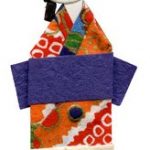
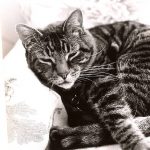
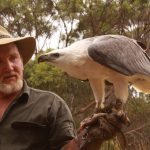
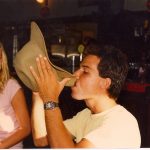

Leave a Reply